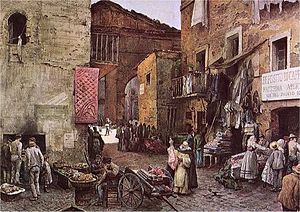Roman ghetto
| Roman Ghetto | |
|---|---|
|
Native name Italian: Ghetto di Roma |
|

Via Rua in Ghetto, (rione Sant'Angelo), by Ettore Roesler Franz (c. 1880)
|
|
| Coordinates | 41°53′33″N 12°28′39″E / 41.8924°N 12.4775°ECoordinates: 41°53′33″N 12°28′39″E / 41.8924°N 12.4775°E |
| Established | 1555 |
| Demolished | 1888 |
| Architect | Giovanni Sallustio Peruzzi |
The Roman Ghetto or Ghetto of Rome, (Italian: Ghetto di Roma), was a Jewish ghetto established in 1555 in the Rione Sant'Angelo, in Rome, Italy, in the area surrounded by present-day Via del Portico d'Ottavia, Lungotevere dei Cenci, Via del Progresso and Via di Santa Maria del Pianto, close to the River Tiber and the Theatre of Marcellus. With the exception of brief periods under Napoleon from 1808 to 1815 and under the Roman Republics of 1798-99 and 1849, the ghetto of Rome was controlled by the papacy until the capture of Rome in 1870.
The Roman Ghetto was established as a result of Papal bull Cum nimis absurdum, promulgated by Pope Paul IV on 14 July 1555. The bull also required the Jews of Rome, which had existed as a community since before Christian times and which numbered about 2,000 at the time, to live in the ghetto. The ghetto was a walled quarter with its gates locked at night. The wall was built under the direction of the architect Giovanni Sallustio Peruzzi. The cost of the wall's construction, 300 Roman scudi, had to be paid by the Jewish community. The area of Rome chosen for the ghetto was one of the most undesirable quarters of the city, subject to constant flooding by the Tiber River, but where Jews amounted already to 80% of the population. At the time of its founding, the area was a trapezoid whose bases (parallel to the river) measured respectively 270 m (890 ft) (near the Tiber) and 180 m (590 ft), and whose sides was about 150 m (490 ft) long. The wall started from Ponte Fabricio reaching the Portico d'Ottavia; from there it run along today's Via del Portico d'Ottavia (not including the ancient fish market (Italian: La Pescheria); at Piazza Giudea (which was cut in two) it bent again running along Vicolo Cenci (today Via del Progresso) until it reached the Tiber again. The total area amounted to three hectares. At the time of Sixtus V (late 1580s), roughly 3,500 inhabitants were living in inhuman conditions.
...
Wikipedia
